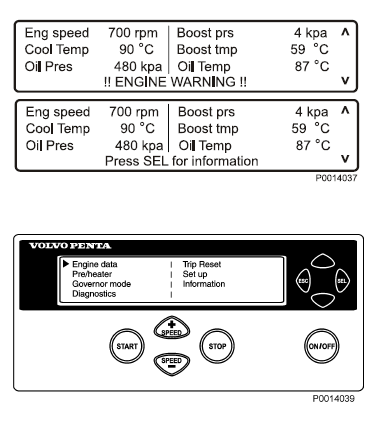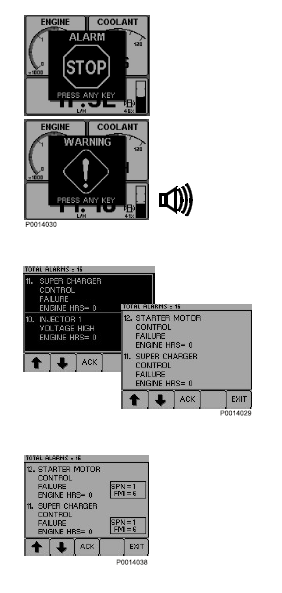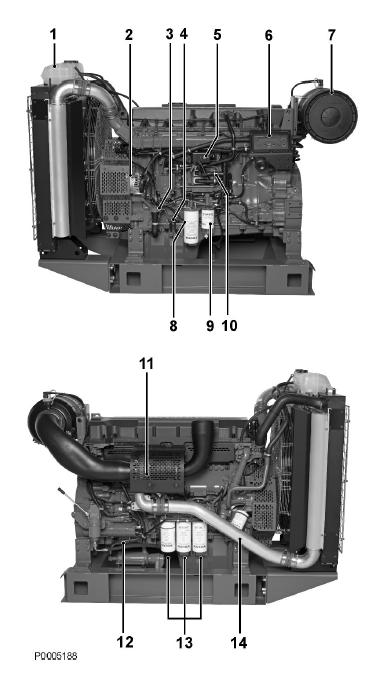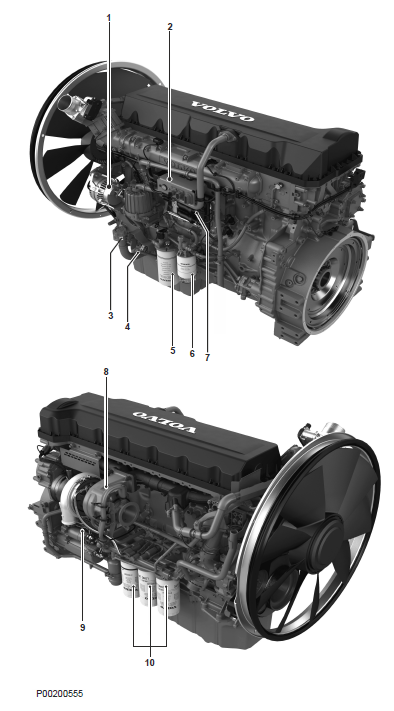Fault Handling
Diagnostic Function
The purpose of the diagnostic function is to monitor and control the engine and EATS, as well as to protect components from damage. If a malfunction is detected the diagnostic function informs of the occurred fault in the form of a fault code. The fault code provides guidance when fault tracing. All fault codes and fault messages can be found in the Fault Code Register. The operator is warned that there is a malfunction via the instruments. Depending on the instrumentation in use, the fault message is shown in various ways. Fault codes can also be read out by the Volvo Penta diagnostic tool. Depending on the severity of the fault, the diagnostic function will take various actions to protect the engine (e.g. torque derate, idle speed only, engine shut down etc. )
DCU (Display Control unit)
1 When a fault is detected the following text is displayed:
!! ENGINE WARNING !! alternating with Press SEL for information.
2 Reduce engine speed to idle or shut down the engine.
3 Press the SEL button to get to the fault list.
The fault list shows:
– hours of operation
– fault messages
– active/non-active faults
4 Look up the fault code in the Fault Code Register and take the necessary actions.
5 Press ESC to leave the fault list.
NOTICE! To get to the fault list when no fault codes are set, press the SEL button and select Diagnostics from the menu.

DU (Display Unit)
1 If the system detects a fault, a pop-up is shown on the display. Depending on the severity of the fault the following text will appear
ALARM STOP / PRESS ANY KEY or
WARNING! / PRESS ANY KEY; a buzzer will sound.
2 Reduce engine speed to idle or shut down the engine.
3 Press the SEL button to get to the fault list. The fault list shows fault messages and the number of hours of operation when the fault occurred.
4 Press ACK to acknowledge the fault code. The display background changes color (and the buzzer stops). The fault must be acknowledged before it can disappear from the fault list.
5 Look up the fault code in the Fault Code Register and take the necessary actions.
6 Press button 4 for at least three seconds to view SPN and FMI codes.
7 Press EXIT to leave the fault list.

CIU (Control Interface Unit)
When the system detects a malfunction, the diagnostics lamp flashes. If the diagnostics button is pressed and then released, a fault code is flashed out. The fault code consists of two groups of flashes, separated by a pause of two seconds. A fault code is obtained by counting the number of flashes in each group.
Example
pause = fault code 2.4
The fault code is stored and can be read off as long as the malfunction remains. Information about causes, effects and actions required is available in the Fault Code chapter.
Do as follows to read off the fault code:
1 Press the diagnostics button.
2 Release the diagnostics button and note down the fault that is flashed out.
3 Repeat items 1–2. A new fault code will be flashed out if more faults are stored. Repeat until the first fault code reappears.
NOTICE! When the first fault code reappears, all fault codes have been read off.
If the diagnostics button is pressed after the fault has been rectified and the fault codes have been erased, code 1.1 “No fault” will be displayed.
Easy Link Instruments
1 When a malfunction is detected this is reported by the diagnostic lamp which starts to flash.
2 Press the diagnostics button. The fault code is shown as text in the tachometer display.
3 Look up the fault code in the Fault Code Register and take the necessary actions.
4 When the fault has been rectified, the fault code disappears from the display and the diagnostics lamp goes out.
Erasing fault codes
The memory of the diagnostic function is reset when the power to the engine is disconnected. When the power is switched on again, the diagnostic function will check if there are any malfunctions in the system. If so a new fault codes is registered. If a malfunction has not been corrected it will be registered once again and has to be acknowledged again. The Volvo Penta diagnostic tool VODIA must be used to erase a fault code.
Maintenance
This chapter describes the most common maintenance items, see Maintenance Schedule page 44 for service intervals.
NOTICE! Service points which are not described here must be performed by an authorized Volvo Penta workshop.
CAUTION!
Read the chapter on Maintenance before starting work. It contains instructions on how to carry out maintenance and service operations in a safe and correct manner.
WARNING!
Care and maintenance work should be done with the engine stopped unless otherwise specified. Stop the engine before opening or removing the engine hatch/hood. Make it impossible to start the engine by removing the start key and cutting the system voltage with the main switches. Read about security measures for maintenance and service in the chapter Safety Information page 3 before you begin.
Orientation
TAD1340VE, TAD1341GE, TAD1341VE,
TAD1342GE, TAD1342VE, TAD1343GE,
TAD1343VE, TAD1344GE, TAD1344VE,
TAD1345GE, TAD1345VE, TAD1350GE,
TAD1350VE, TAD1351GE, TAD1352GE,
TAD1353GE, TAD1354GE, TAD1355GE
1 Expansion tank
2 Alternator
3 Oil filler cap, engine
4 Oil dipstick
5 Emergency Stop Switch
6 Control Panel
7 Air Filter
8 Fuel Filter
9 Fuel pre-filter with water separator
10 Control Unit, EMS
11 Turbo
12 Starter motor
13 Oil filter
14 Coolant Filter

Orientation
TAD1351VE, TAD1352VE, TAD1353VE
1 Alternator
2 Emergency Stop Switch
3 Oil filler cap, engine
4 Oil dipstick
5 Fuel Filter
6 Fuel pre-filter with water separator
7 Control Unit, EMS
8 Turbo
9 Starter motor
10 Oil filter

For More Volvo Engine workshop information, please visit:
Volvo Engine Display Control Unit and Display Unit
Instructions to Check Volvo Engine Before Starting
Copyright © Guangxi Dingbo Generator Set Manufacturing Co., Ltd. All Rights Reserved | Sitemap
Update cookies preferences